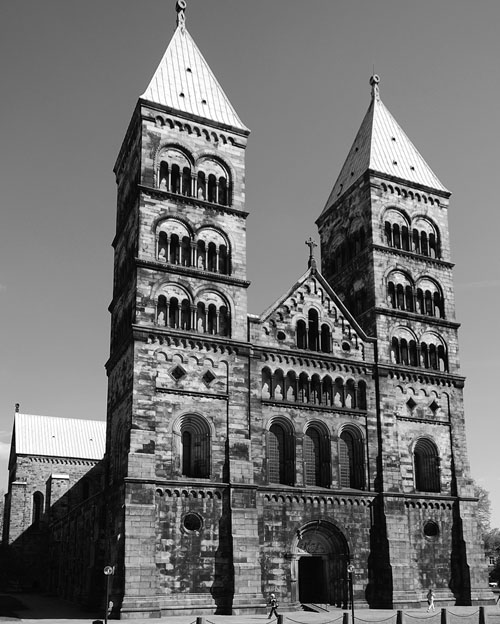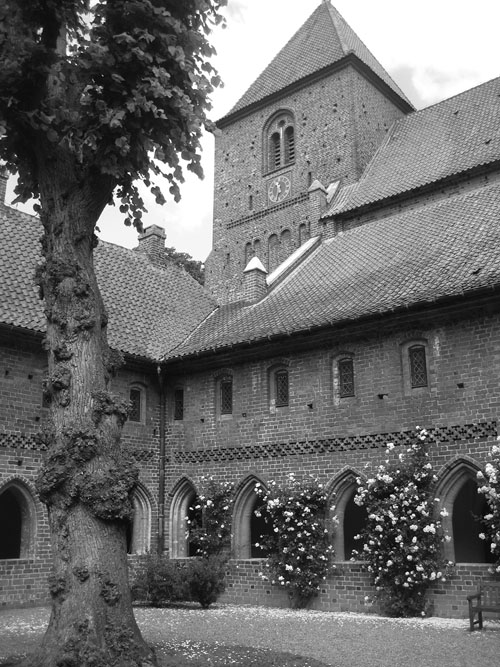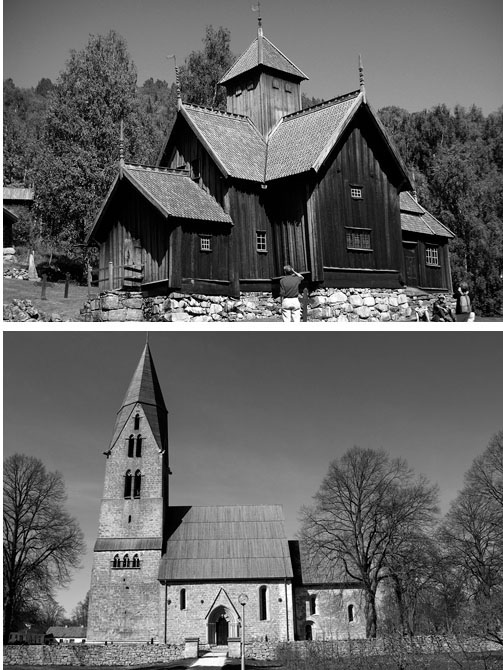Cross and Scepter (11 page)
Authors: Sverre Bagge

It seems that the tenth-century conversions took place in a period when there was a relative balance of power between the old and the new parts of Europe. The old monarchies, Anglo-Saxon England and imperial Germany, were strong enough to serve as important models for rulers of the new kingdoms, but not to conquer them. By contrast, the increased strength of the Christian kingdoms in the following period, which now also included previously pagan areas like Denmark and Poland, shifted the balance of power and made pagan areas targets for conquest, a trend that was stimulated by the growth of the crusading ideology, which
mobilized the secular aristocracy for the cause of Christianity. Thus, early and voluntary Christianization was an important asset for the six kingdoms, whereas those that remained pagan until the mid-twelfth century became the victims of conquest. This in turn points to the importance of Christianity for state formation, not only for the development of the internal organization of the countries but also for the formation of territorial kingdoms and principalities.
The Development of the Ecclesiastical Organization
The political centralization that resulted from conversion was furthered through the establishment of an ecclesiastical organization. Christianity in its medieval Catholic form featured an elaborate cult and an equally elaborate doctrine, both of which required the services of a professional priesthood. Whereas pagan cult observances consisted in the main of sacrificial parties, apparently not too unlike ordinary meals presided over by the ordinary leaders of the community, the main Christian cult, the mass, although originally based on a meal, had in the Middle Ages developed into a highly specialized ceremony. It could only be celebrated by a priest and normally took place in a special building. The original meal had been reduced to a thin wafer and a drop of wine (normally consumed only by the priest). In 1215 the Fourth Lateran Council decided that the laity should receive this meal, termed Holy Communion, once a year, and this was normally the only time they did so. At around the same period, it also became the practice that the laity received the sacrament in the form of bread only, not wine. In addition to Holy Communion or the Sacrament of the Eucharist, there were six other sacraments, given at important stages in life, from birth to death, most of which also had to be administered by the priests. The exception
was marriage, which the partners gave to each other, and baptism, which any Christian could administer if no priest were available. Thus, priests and churches became essential if people were to conduct a Christian life and reach salvation after death.
In addition, the priests had to teach Christian doctrine to new converts and see to it that they lived according to the rules of the Church. In contrast to modern Protestantismâand largely also to modern Catholicism, where Christian ethics is basically an appeal to the individual conscienceâmedieval Catholicism consisted of a panoply of detailed rules, whose observance was monitored by priests and other ecclesiastical authorities. Every four days, on average, there was an ecclesiastical holiday when it was forbidden to work. Every Friday was a day of abstinence, when it was forbidden to eat meat or to have sexual intercourse. These prohibitions were also in effect at various other times, the most important of which were the four weeks before Christmas and the seven weeks before Easter. Characteristically, the Icelandic historian Snorri Sturluson (1179â1241) summarized the pagans' objections to Christianity in the statement that people were forbidden to work and to eat. Transgressions of these rules were punished by fines, and the priest or the bishop's local representative was responsible for bringing the culprit to justice. In addition, the Church introduced new rules governing marriage, defining it as a voluntary agreement between a man and a woman, not, as previously, a contract between two kindred. The church also prohibited divorce and incest, the latter originally defined as marriage between partners related in the seventh degree, but in 1215 reduced to the fourth. Most of these provisions were established by law, and breaches were prosecuted at the local assemblies or, eventually, at separate ecclesiastical courts. The same applied to the use of magic, pagan cult, or doctrines opposed to that of the Church. Thus, there was a sliding transition between cult and doctrine on the one hand and government and the administration of
justice on the other. Functions of both kinds necessitated a considerable bureaucracy.
Of the Scandinavian countries, Denmark was the first to have an ecclesiastical organization that conformed to European norms. Its precedence was due partly to the early introduction of Christianity in this country, partly to the greater influence there of the German mission, which was more concerned with organizational issues than was the English mission. Despite the formal division of Denmark into dioceses as early as 948, the Danish diocesan organization with eight dioceses in practice dates from around 1060. Regular dioceses were established in Norway in the late eleventh century, but the organization was not fully developed until the mid-twelfth century, when there were five dioceses. In addition, six dioceses on the Atlantic isles belonged to the Church province of Nidaros. In Sweden, the first diocese, that of Skara, was founded in 1015. The country was later divided into seven. In 1104, Scandinavia became an independent church province with its archbishop's see at Lund in Denmark (now in Sweden).
The province was further divided in 1152/53, when Norway got its own archbishop in Nidaros, and in 1164 with the establishment of a Swedish archbishopric, centered in Uppsala. Cathedral chapters developed in the three kingdoms around the time of the foundation of the church provinces, but not in Iceland or in some of the smaller dioceses on the Atlantic isles. Beginning in the twelfth and above all in the thirteenth century, diocesan organization was further elaborated, with a growing array of provosts, archdeacons, and other officials engaged in administrative and judicial duties. There were, however, considerable differences between dioceses, commensurate with their relative wealth and size. The first Benedictine monasteries were founded in Denmark in the late eleventh century and in Norway in the early twelfth. The earliest monasteries in Sweden were the Cistercian foundations of Alvastra and Nydala, both dating from 1143. At the same time, Cistercian monasteries were founded in the other countries as well. The clerical orders that became popular in the rest of Europe during the twelfth century, the Augustinians and Premonstratensians, were also introduced to Scandinavia around this time. The mendicants arrived relatively early. The first Dominicans settled in Lund in Denmark under the patronage of Archbishop Anders Sunesen in 1223 and established their Scandinavian province (Dacia) in 1228. The Franciscans came from Germany to Denmark in 1232 and established their province of Dacia in 1239. Twenty of their thirty-one Scandinavian houses were established before 1250.

Figure 4.
Lund Cathedral (Denmark), now in Sweden. Built in a German-influenced Romanesque style. The cathedral was consecrated in 1145 and dedicated to St Lawrence. It was restored 1860â80. Photo: Anton Holmquist. Wikimedia Commons.
Parish organization took shape gradually. In Denmark, a period of intense church building began in the eleventh century, mostly under the direction of kings and magnates, and eventually resulted in the division of the country into parishes. The introduction of the tithe from around 1100 was an important factor in this development. In Norway, an organization of churches for large districts is found in the provincial laws from the late eleventh or early twelfth century on, but it is doubtful to what extent this represented actual organization. In any case, the parish organization we meet in the thirteenth century and later is largely based on the numerous churches built by local magnates who wanted to have a church in the vicinity of their estates. As in Denmark, the introduction of the tithe is regarded as an important factor in the development of parish organization. According to the sagas, the tithe was introduced by King Sigurd in the 1120s, but it most likely did not become a regular contribution until the second half of the century. A large number of churches seem to have been built over a short period, although somewhat later than in Denmark, in the late twelfth and early thirteenth century. Swedish parish organization developed in a similar way as in the neighboring countries, but at a somewhat later date.
The development of the Scandinavian churches from modest beginnings to wealthy and powerful institutions can to some extent be traced in the sources. A paragraph in the Norwegian Law of Gulating, probably from the first half of the twelfth century, states that priests should no longer be beaten when they have offended but should instead pay fines, which was the normal punishment for free men. The paragraph adds that they have now become respectable men to whom members of the local communities might marry their daughtersâclerical celibacy was still unknown at this date. In Denmark, some papal letters from the 1070s complained that priests were blamed for natural disasters and severely persecuted, which again points to their low status, although we do not know whether this refers to their customary treatment or only to some individual cases. Whereas priests and bishops were in the beginning often foreigners, these offices were gradually taken over by indigenous candidates from the twelfth century onwards. It is particularly significant that members of the high aristocracy became bishops, a sure sign that the office had become a prestigious one, that the Church had become wealthy, and that its most prominent servants played a powerful role in society. Ecclesiastical wealth also increased as the result of gifts from the king and the aristocracy, including the bishops themselves, who often gave a part of their fortunes to their churches.

Figure 5.
The Dominican House in Ribe (Denmark). Fifteenth century. The building complex is almost completely preserved. The Dominicans normally settled in towns. They were active as preachers and confessors and were often well educated. Unknown photographer.

Figure 6.
Two local churches of the Middle Ages.
A.
The tiny stave church in the mountain community of Uvdal (Norway). The construction of the church can be dated to 1168 through dendrochronology. It was extended in the eighteenth and early nineteenth century. Photo: Linn Marie Krogsrud. Middelaldernett.
B.
The monumental Ãja stone church on the wealthy island of Gotland (Sweden). Its oldest parts date from the early thirteenth century. Around a hundred stone churches of the Middle Ages are still preserved on the island, often referred to as “parish cathedrals.” Ãja is one of the largest, and in addition is richly decorated. Photo: Therese Foldvik. Middelaldernett.
Compared to the other new countries of Western Christendom, Poland, Hungary, and Bohemia, the organization of dioceses came late to Scandinavia; in the three eastern countries, they were introduced very soon after conversion. The greater emphasis placed on formal ecclesiastical organization by the German Church in contrast to the English was in part responsible, but a strong wish by the rulers of the converted countries to establish their equality to and independence of the strong German Empire was also a factor. The latter also explains why Poland and Hungary became independent church provinces already in the early eleventh century, whereas Bohemia, closer to Germany and more dependent on this country, had to wait until 1344. Scotland had to wait even longer; the Scottish church was under the Archbishop of York until 1472. The Scandinavian church provinces came earlier than this but later than those of Poland and Hungary. They might have been even further postponed were it not for the Investiture Contest and the conflicts that followed it between the pope and the emperor. The province of Lund was erected in 1103, when the Archbishop of Hamburg-Bremen sided with the emperor against the pope. Nidaros in 1152/53 came at a time when the Archbishop of Hamburg-Bremen tried to reassert
his superiority over the Scandinavian churches, and although there was at the time no open conflict between the emperor and the pope, the latter may have judged a division of the province of Lund to be a useful precaution. Finally, the Swedish province came during the papal schism, when the Danish king sided with the anti-pope Victor IV.
